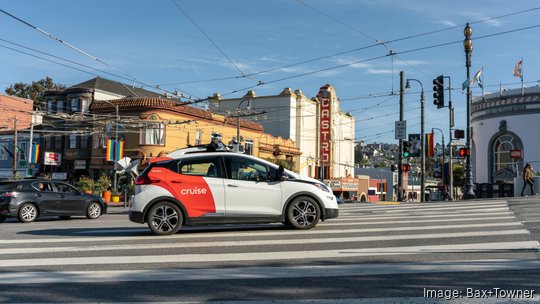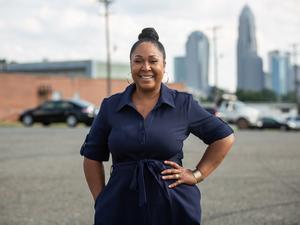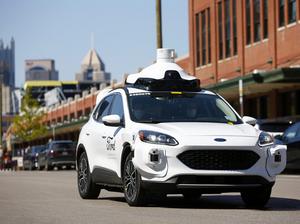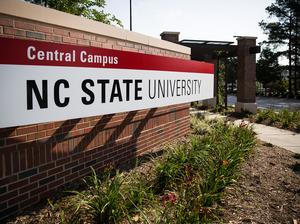
Driverless cars may some day become a new normal on Charlotte roadways, thanks to Cruise, an autonomous vehicle ride-hailing startup based in San Francisco.
The company announced on social media last week it was testing its self-driving, all-electric cars in the Queen City. That initial testing ran from Aug. 15-20. Cruise has also tested its vehicles in Miami, Nashville and Atlanta. It is already operating in San Francisco, Austin and Phoenix.
"We’re in the early days of getting to know Charlotte, but you might start to see our cars around as we get used to the city’s driving environment," a Cruise spokesperson told CBJ.
Although the cars had a driver behind the wheel during the initial testing here, the thought of self-driving vehicles steering real-world traffic scenarios such as congestion can be cause for concern.
A group of researchers at UNC Charlotte have been studying autonomous vehicles and potential impacts of their coexistence with human-driven automobiles. Amir Ghasemi, a mechanical engineering and engineering science assistant professor at UNC Charlotte, is also co-principal investigator on the N.C. Department of Transportation project that brought CASSI to the school's campus. CASSI is an electric, self-driving shuttle than can seat up to eight passengers and an attendant. That six-month pilot project launched on July 12 and runs until Dec. 22.
How can driverless cars transform ride-hailing services?
Ghasemi's research focuses on the "dynamic transfer of control authority between humans and automation." He said implementing self-driving cars for ride-hailing purposes could have several benefits.
That includes reduced traffic congestion and air pollution, improved road safety due to reduced human error and increased accessibility for people with mobility challenges, especially in zones with limited public transit options, he said. It could also improve the convenience and affordability of transportation for locals, Ghasemi said.
According to data from Cruise, more than 40,000 people die each year from car accidents, primarily due to human error. The company aims to reduce that leading cause of crashes.
Dr. Wei Fan, civil and environmental engineering professor at UNC Charlotte, who also researches autonomous vehicles, said driverless cars could become a highly competitive market for transportation networks such as Uber and Lyft.
Drivers for those companies generally keep about 75% of their fare price for each ride. However, Fan said ride-hailing networks like Uber could also begin to run a fleet of autonomous vehicles, collecting the 75% that would have gone to the driver.
"For current drivers who work with Uber and Lyft, this will be bad news to them," he said.
But it would be good news for travelers, as driverless cars could mean less waiting time to receive confirmation of a ride-booking order, Fan said. That would require someone to monitor the ride-hailing screen or app 24/7.
Autonomous vehicle manufacturers could also launch their own ride-hailing service or app in the future, making the market even more competitive.
What are real-world traffic scenarios autonomous vehicles could encounter?
Some concerns with driverless cars include their ability to navigate complex and unpredictable circumstances, potential vulnerabilities to cyber attacks, legal and liability issues in the event of an accident, sharing the road with human-driven vehicles and possibly replacing drivers' jobs, Ghasemi said.
The vehicles could also have issues with first responders, emergency vehicles, construction zones and bad weather conditions, Fan said.
Additionally, autonomous vehicles will need to learn how to navigate complex intersections, merging on a highway, cyclists and other unpredictable situations. To survive in these scenarios, self-driving cars would require advanced sensors, AI algorithms and communication systems to ensure safe travels, Ghasemi said.
Fan said there are six levels of vehicular autonomy — ranging from zero, where someone is driving the car to supervise its automated features, to five, where a driver is not required to take over operating the vehicle.
"Currently, we are far from a level-five automation since there are many situations with which autonomous vehicles cannot yet cope," Fan said.
While autonomous vehicles face significant challenges, the technology could attract innovation and investment to the Charlotte region, Ghasemi said.
"It's clear that while autonomous vehicles offer significant potential benefits, challenges related to technical robustness, safety validation, public acceptance, legal frameworks and infrastructure readiness need to be addressed," Ghasemi said, attributed to his research. "The transition to a world with both human-driven and autonomous vehicles requires careful planning to ensure smooth coexistence and integration."






